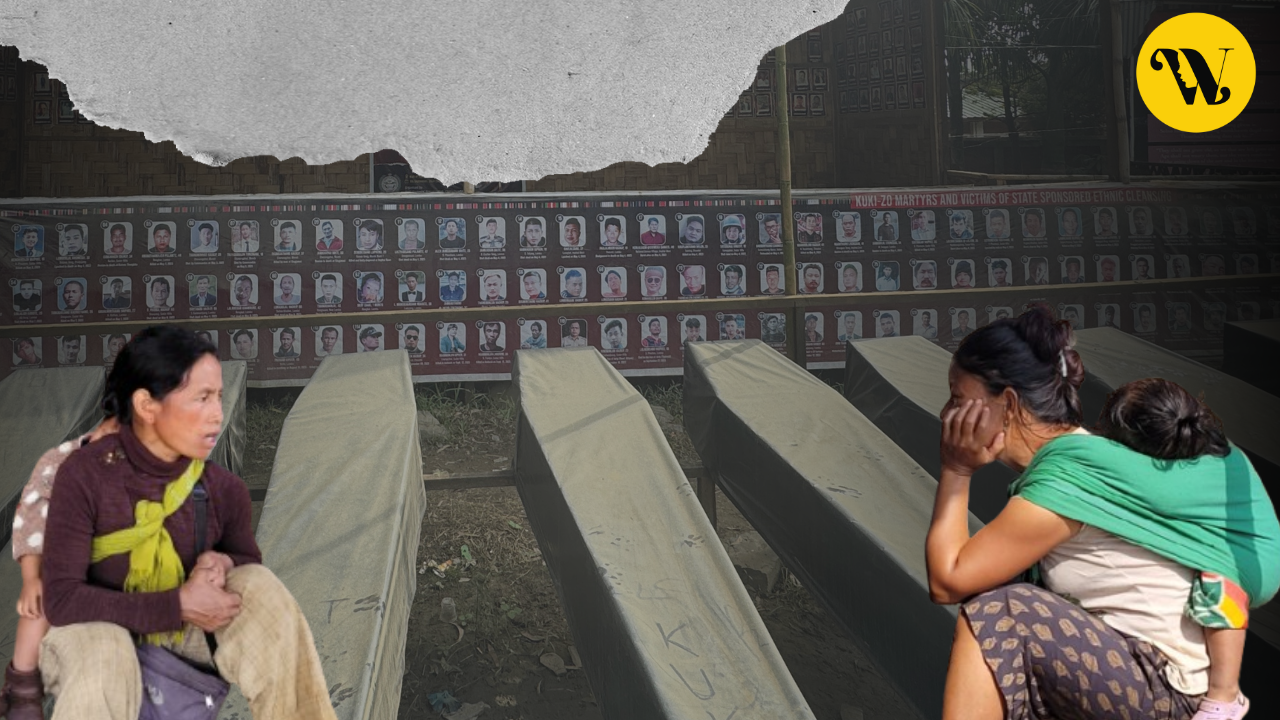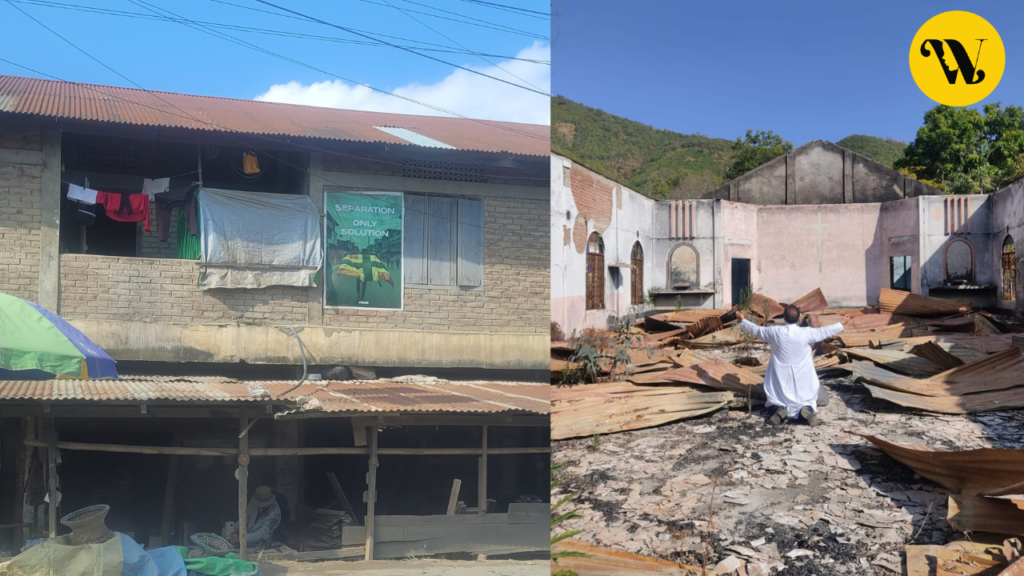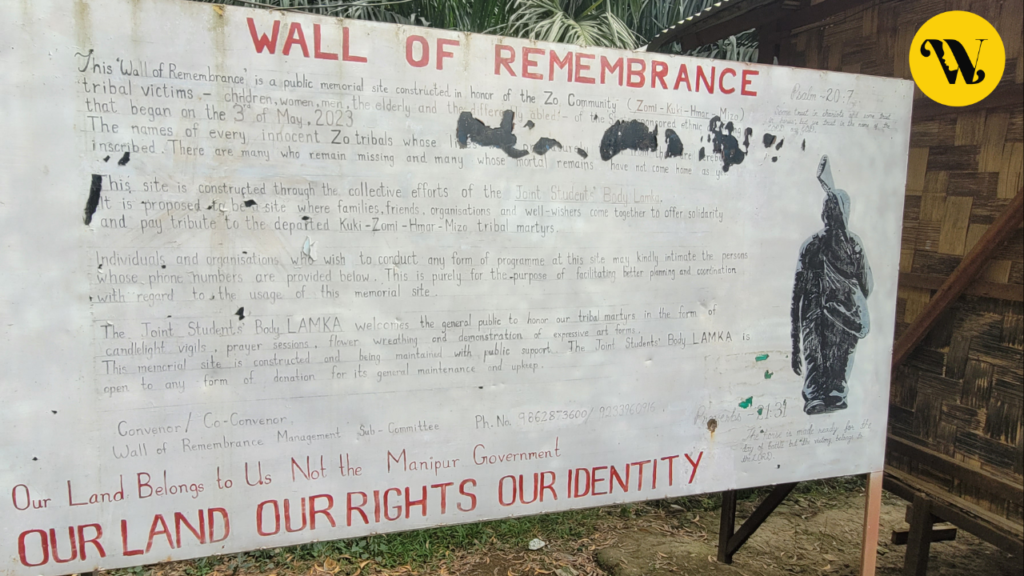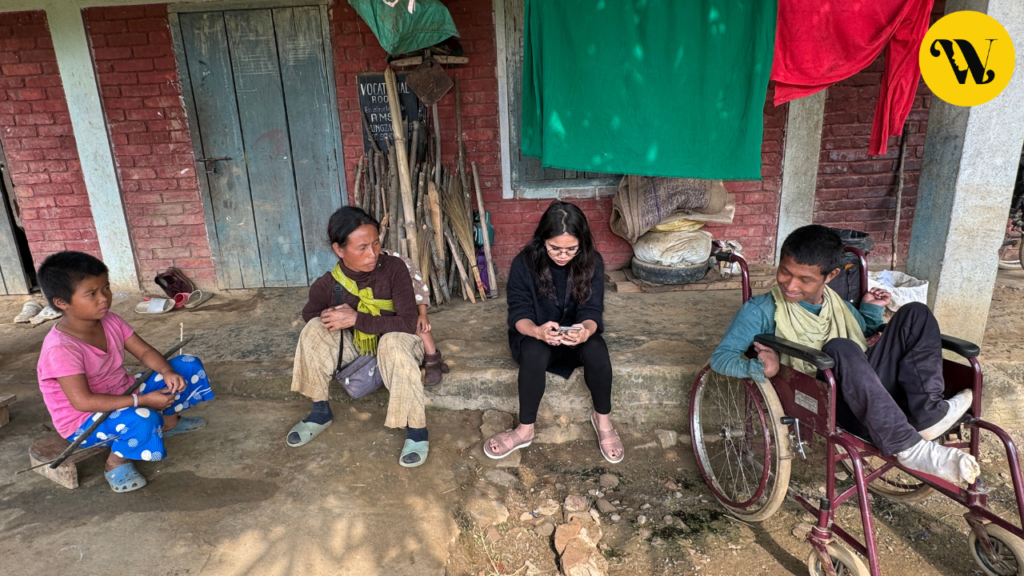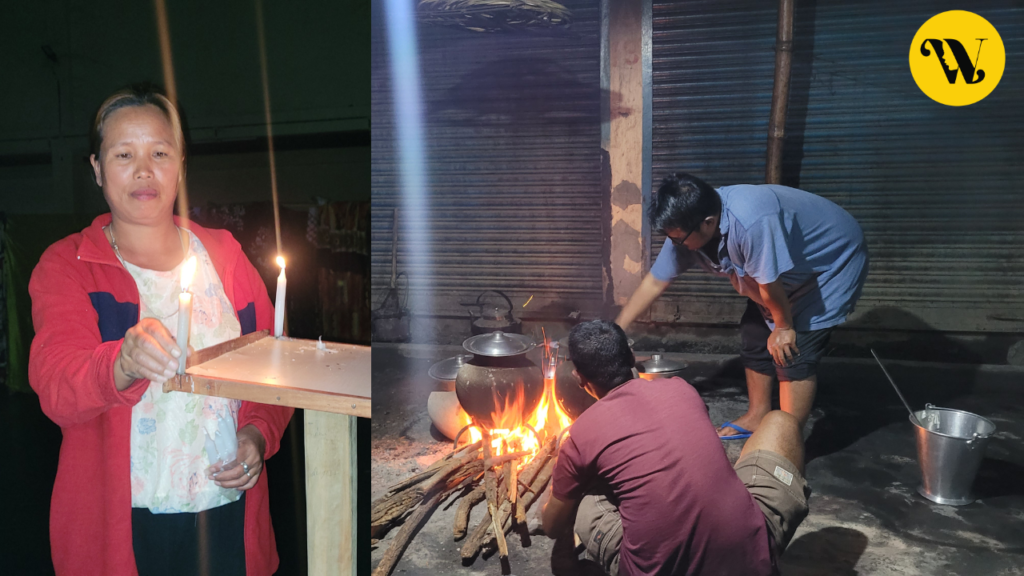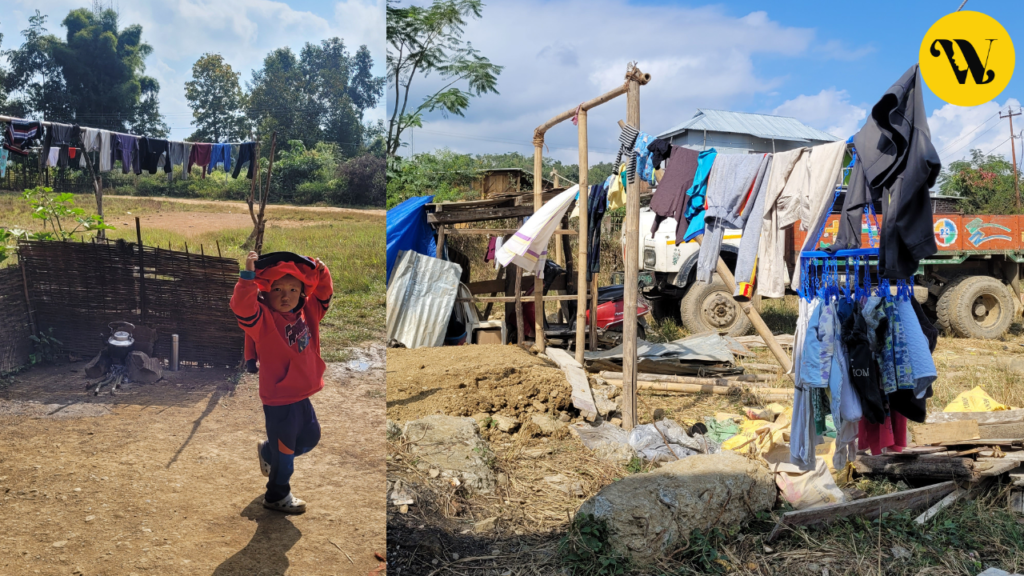By Kashish Singh
(Trigger Warning: Conflict Reportage might include incidents sensitive to some viewers)
On the 3rd of May 2023 around 6 pm in the evening in Imphal, a mob caught her husband and started beating him black and blue. While holding her child she tried to stop the mob from beating him, and that’s when she was also enfolded in the violence and forced to say that they were refugees. In desperate hopes, she said whatever they asked her to say. Even after that, her husband was assaulted, her clothes were ripped apart, and she was slapped several times by the mob.
Manipur: Silence is the loudest sound. As we entered Imphal Valley, the capital city of Manipur, I felt an eerie silence that couldn’t be mistaken for peace. The beautiful northeastern state is missing from the Map of India. It has become a forgotten state.
All one could see while traveling in Manipur right now are scenes of people being hounded out of their lives, rounded up, and herded into camps bifurcated based on community. When we visited the relief camps of both the major communities, Kuki and Meitei, all I could spot was helplessness. Zoned-out faces were looking at the sky remembering their murdered family members, their teary eyes filled with the willingness to return to their homes that now are being burnt and vandalized by an angry mob.
The catastrophe that is unfolding in Manipur is slow violence without seeming urgency, making it difficult to recognize how much harm has been done until months or even years later. It perpetuates a vicious cycle where people normalize these heinous acts or get desensitized to them. But for the people suffering their day in and day out, there is no escape from this horror.
“Behind the deceptive words designed to entice people into supporting violence~ words like democracy, freedom, self-defense, national security- there is the reality of enormous wealth in the hands of few, while billions of people in the world are hungry, sick, homeless.” – Howard Zinn
The mayhem came on 3rd May 2023. Manipur has been burning since then. It’s been more than 18 months, and still, the central government of Bhartiya Janta Party led by Prime Minister Narendra Modi has turned a blind eye. The state government of the same party, led by Chief Minister N Biren Singh, has made zilch efforts to restore peace according to the people in Manipur.
Many people have lost their lives amidst the ongoing war-like situation but the question is who’s responsible for all these innocent lives? What’s at the core of the dispute in Manipur and most importantly how can this conflict end? We went to ground zero to search for these answers.
Amidst the Ongoing Conflict, Manipur Witnesses Intra-State Borders Known as Buffer Zones
Manipur has entered an unprecedented time where borders have been drawn within the state. The people of Manipur practice two major religions- Hinduism and Christianity. The state accounts for around 53% of Meitei (predominantly Hindus), around 20% of Naga tribes (mix of Buddhism, Christianity and Hindus) and around 16% of Kuki-Zo tribes (predominantly Christians). Muslims make up 8.4% population of the state.
In Manipur, the majority Meitei population resides in the valley area which constitutes the major part of Imphal city, while the Kukis and Nagas are primarily concentrated in the hills, which surround Imphal on all sides. All major institutions and government offices, including the State Legislative Assembly and the High Court of Manipur, are also concentrated in the valley region which makes up 10% of Manipur’s total area. The hills cover the remaining 90%.
On our five-day visit to Manipur, we traveled to four districts and every time we entered a new district there came a checkpoint known as a ‘buffer zone’. While traveling from Imphal to Churachandpur district we went through a rigorous screening process at 4-5 checkpoints out of which some were dominated by the army groups and others by local village volunteers guarding their villages.
This is what happens when government leaves the citizens to fend for themselves! We were stopped on our way from Imphal to Kangpokpi district for inquiries. Interestingly, we were advised to hire a Muslim taxi driver to commute from one district to another because Muslims are comparatively safer in the state amidst the ethnic tensions between Meiteis and Kukis. What a paradox, I thought!
When we stopped at the checkpoint, I saw women of all age groups sitting under a shade. To my curiosity, I got out of the car to ask why these women were there. To my surprise, I learned that they were protecting Meitei people from crossing the border to this district & from Kukis going to the Imphal side to ensure all of their safety. These women were from the Kuki tribes guarding the intra-state border from the wee hours in the morning to late evening till it got dark. Then a group of men would take over the shift for a smooth process. They all belonged to different villages.
One of the men around informed us that just recently, three Meitei young people were caught in the Kuki-land (on the Kuki side of the border) but it was these women guarding the buffer zone that ensured their release for their safety and the region’s overall peace. The irony did not escape me – while the women’s bodies were being treated by both sides as ‘sites of power’, these women who were at the forefront of the buffer zone still managed to prioritize peace over all else, by releasing the Meitei men.
I then spoke with a young girl about what unfolded on May 3rd, 2023. She recalled the details of the initial days saying, “Kuki tribes were having a solidarity march to oppose providing ST status to the Meitei community, in retaliation some Meitei people started burning the Anglo-Kuki War Memorial Gate in Churachandpur District.”
“The crowd appeared to have plotted their attack and was ready to attack. Before we knew it, they had begun throwing stones at us. The state police were also present, and our Kuki tribe volunteers were unarmed at the time. They quickly began hurling tear gas at us. By this time both sides were angry and later the Meitei people started burning some houses,” she added.
On asking about the state police helping when all of this was happening, she replied, “They observed the incident from afar but they didn’t take any action, had they taken any action the conflict wouldn’t have escalated to the level it is today.”
Plight of thousands of ‘Internally Displaced People’ (IDPs) Overshadowed
People on both sides ran at night through jungles to save their lives as the houses in their vicinity burned and in no time their own houses were on the radar. The Meiteis were driving out all Kukis from Imphal and other Meitei-dominated villages, and Kukis were doing the same. The plight of thousands of these displaced people is not enough to sway the Central Government to intervene.
Because of the escalating tensions and large-scale violence, the situation is such that there are no Kukis in Imphal now.
The relief camps situated in Imphal, Meitei dominated, were still in a better condition, for government-offered help reached these camps. On the other side, Kuki Tribes’ relief camps situated in different districts lacked basic requirements.
We visited and spoke to people living in both these camps. In Imphal–East and West, trade centers and covered marketplaces were converted into relief camps. People living there told us they were getting rice, grains, spices, and bananas from the government along with Rs. 80 per IDP (Internally Displaced Person) to support themselves.
People living in Churachandpur & Kangpokpi district relief camps received only basic ration such as rice, with the local village people pooling in for the majority of their subsistence items.
When I entered the old school premises turned into a relief camp for Kuki people in the Churachandpur district, I witnessed something heart-wrenching. People were forced to sell leftover food to meet their basic daily needs and support their children, and of course, people were buying this cheaply available food because their entire life was wrecked, their houses burned, and family members were killed, with no money in their pockets. They have been displaced overnight and they have no source of income amidst the ongoing violence in the state.
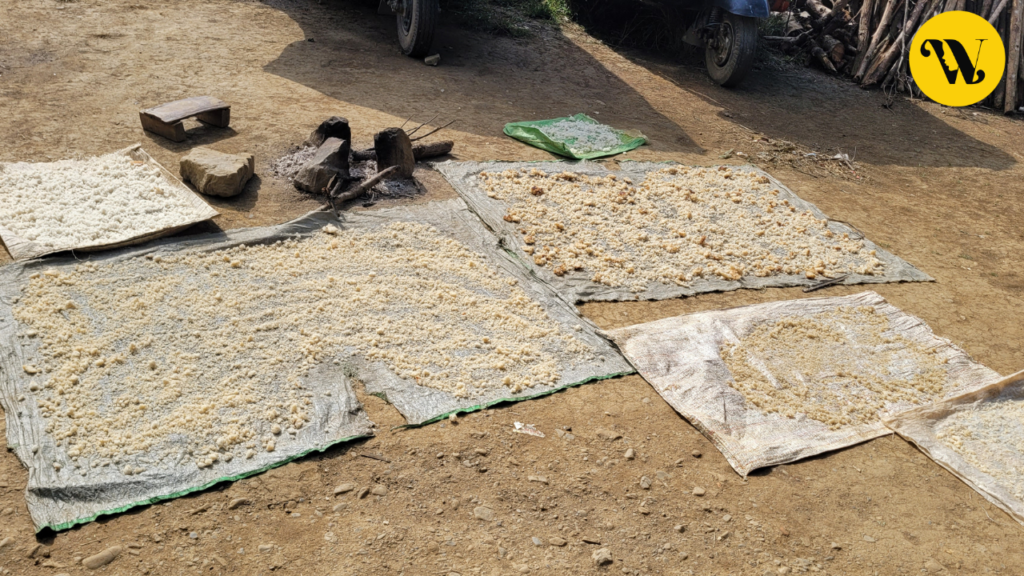
While the condition of the people living in relief camps on both Meitei and Kuki side are deplorable, there was still a clear visible contrast. The Meitei camps were larger and better organized, with relatively better ration but the Kuki camps were much smaller, and lesser organized.
Zooming-in on the lives in the relief camps, exposed the challenges galore. No money to survive is the first major one. In some Meitei relief camps, women were making handbags and jute stools to support their families with what little they could. While they kept making these in heaps, they still hadn’t figured out who to sell it to?! When I asked one of them – “why are you making these jute bags”, she replied – “that is the only way for me to quieten my mind amidst the chaos, it gives me purpose, and hopefully I will be able to get my child some toys, with that little extra money. Children don’t yet fully understand the fate that we have met yet, and I prefer to keep it like that.”
Privacy is the other major one. Women living in relief camps had to share a small room with 6-7 people and in some cases even more. There was a common washroom for everyone to use. Now with the beginning of winter, they were in dire need of blankets and mattresses.
The government has provided them with a stubble-filled mattress that was uncomfortable to sleep. Women shared their hardships saying there were even stones in the mattresses because they were made from stubble from the field.
Many children were living in the relief camps on both sides with limited access to education. Their future was being jeopardized amidst the crisis. Many of these children were not going to school because their parents could not afford their fees with the bare minimum resources left.
Women in all relief camps spoke at length about the financial crisis they were dealing with. One expressed concern that many young people were committing suicide because they lost their private jobs and now, they couldn’t find any means of income.
In a lighter vein yet with an inexplicable seriousness in her voice, one woman said – “there are many boys in the age group of 25-35 in this camp. How will they get married? Who will give their daughters in a relief camp? What will happen to these boys and their future? Girls, we could still marry them off, but boys – I am worried for them.” She continued – “The Government needs to provide some sort of employment opportunity to engage the young, lest their entire futures are ruined.”
Victims Share Gruesome Details & A Pattern of Brutality
In this long ongoing violence, there’s one thing that has been constant which is a pattern of brutality in killing people on both sides. A girl from the Kuki tribe shared a shocking incident of her childhood friend being raped and killed in Imphal when the violence broke out last year.
“Florence was a young timid girl, living in a rented apartment along with her friend. The apartment was owned by a Meitei woman in Imphal. When the news of the arson broke out in the adjacent district everyone was looking for a safe place to hide. Florence decided to hide in her apartment fearing Arambai Tenggol (a Meitei activist organization) would find her. Arambai Tenggols were taking a stroll in the city openly to kill any Kuki people they found. She had nowhere to go and no one came to her rescue”
The girl was sobbing while narrating the incident, holding back her tears she went on, “The owner of the house, a Meitei woman, grabbed these two girls and gave them in the custody of Arambai Tenggols saying take them and rape them because this is war, everything is justified.”
Later everyone in the village found out about the gruesome incident through social media where the details of both girls’ murders suggested that they were raped and tortured as their private parts were cut with a knife. After a few weeks, their cold-blooded body photos were also released on social media.
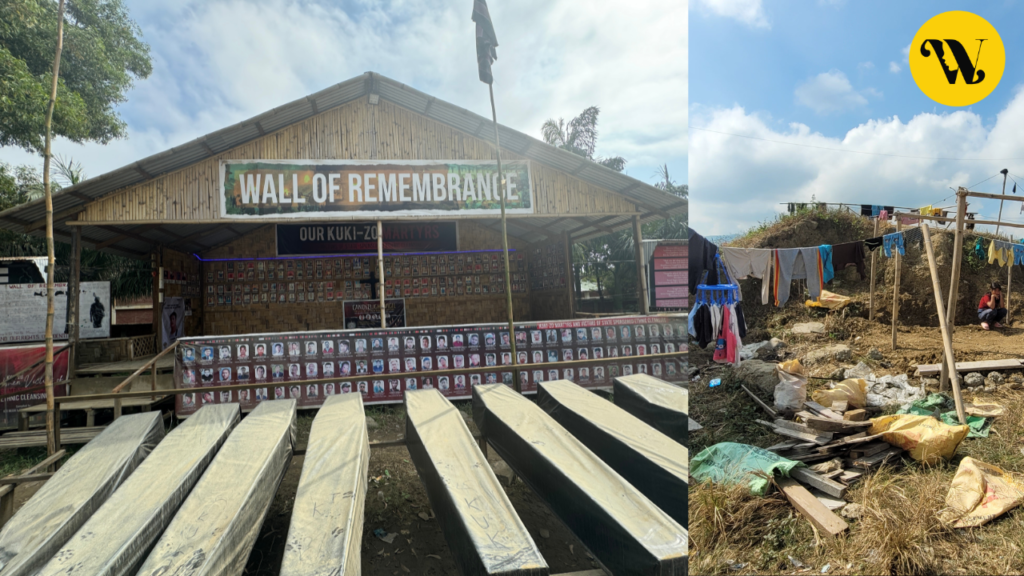
Manipur is witnessing a fresh spate of violence with the killing of 3 Meitei Women and children in Jiribam. We traveled to Jiribam to meet the victim’s family. The distance between Imphal to Jiribam is 216 km but it is a 12-hour-long journey by road given the difficult terrain and multiple landslides on the way. It’s a hilly area with lush green views on both sides of the road. The most difficult part of the journey from Imphal to Jiribam wasn’t the conditions of the roads, multiple closures because of landslides, lack of anything to eat on the way, etc. – it was to convince a driver to actually drive us to Jiribam in the first place. No one agreed, and one who did charged an exorbitant 20 K. The locals felt that it just wasn’t safe. The government chopper did not fly every day and was difficult to get a seat in it anyway.
On reaching Jiribam we met with the victim’s family members in a Meitei relief camp. A little girl who was fluent in Hindi stood with me to narrate the incident of the grisly killing of her grandmother, maternal aunt & siblings. This little girl was an eyewitness when her family members were being dragged out of their house, beaten up, and kidnapped.
“We went back to our village house which is 30-40 km away from the relief camp just to check on our belongings there, that’s when a group came wearing all black. We thought these were Arambai Tenggols but they were Kukis. Seeing them we ran for our lives but my grandmother, Maternal aunt & siblings were inside the house and were abducted by the mob. On the next day, they uploaded my family members’ pictures on social media saying they would kill them. Before we could reach out for some help they killed them and their mutilated bodies were found in a river.”
This little girl appealed to the government and people to do something about Manipur and punish those who have killed her family members. She says, “I had a lot on my mind for my future but now I’m unable to go to school. Now I don’t think that I’ll be able to do something in the future. My future like many other children of Manipur seems bleak.”
The recent incident has raised several questions. There are speculations that it might be a targeted attack from the Meitei groups itself to put the blame on Kukis and escalate tensions further. Many theories arose on this particular incident, with the resignation of Inspector S Ibotombi Singh right after the incident. The area from where these six women and children were abducted is a Meitei-dominated area as told by a local. Therefore, it was nearly impossible for Kuki tribes to enter the area easily without being spotted by deployed army, Meitei organizations, or local village volunteers.
In another incident, in a relief camp in Kangpokpi district sat a woman in a dimly lit room, scrolling through her dead husband’s photos on the phone. I sat next to her to understand what happened to her husband. Her husband was beaten up by the mob and killed.
On the 3rd of May 2023 around 6 in the evening in Imphal, a mob caught her husband and started beating him black and blue. While holding her child she tried to stop the mob from beating him, and that’s when she was also enfolded in the violence and forced to say that they were refugees. In desperate hopes, she said whatever they asked her to say. Even after that, her husband was assaulted, her clothes were ripped apart, and she was slapped several times by the mob.
The mob left her husband barely alive thinking that he was dead, the lady tried contacting multiple hospitals & doctors whom she knew, but all of them refused to help just because she was a Kuki. At this time her husband passed away, and she had to move with her child to ensure their safety.
People Demand Justice, Accountability & Ask Government to Intervene
“There’s no government in Manipur. Both sides suffered major losses but still, there was no intervention. If there was a government there wouldn’t have been a war of this scale. Many women have been raped and killed, yet there’s no action. Because there’s no government, which is why we want a separate administration,” said a young girl belonging to the Kuki tribe.
While this violence has ripped apart the two communities, there was one thing that stood out in common which was their anger toward the government’s inaction and inability to combat the situation. Both communities questioned if the central government thought of the People of Manipur as the citizens of this country because their behavior suggested otherwise.
A 14-year-old girl living in a relief camp shared her hardships and had a clear message for the people in the rest of the country, “Raise your voice for Manipur and help us overcome this conflict.”
“Stop the war and don’t divide our Manipur, we want every community to be safe and we want peace,” a Meitei woman from the group Meira Paibis also appealed to the Government of India.
Women at the Forefront of this War
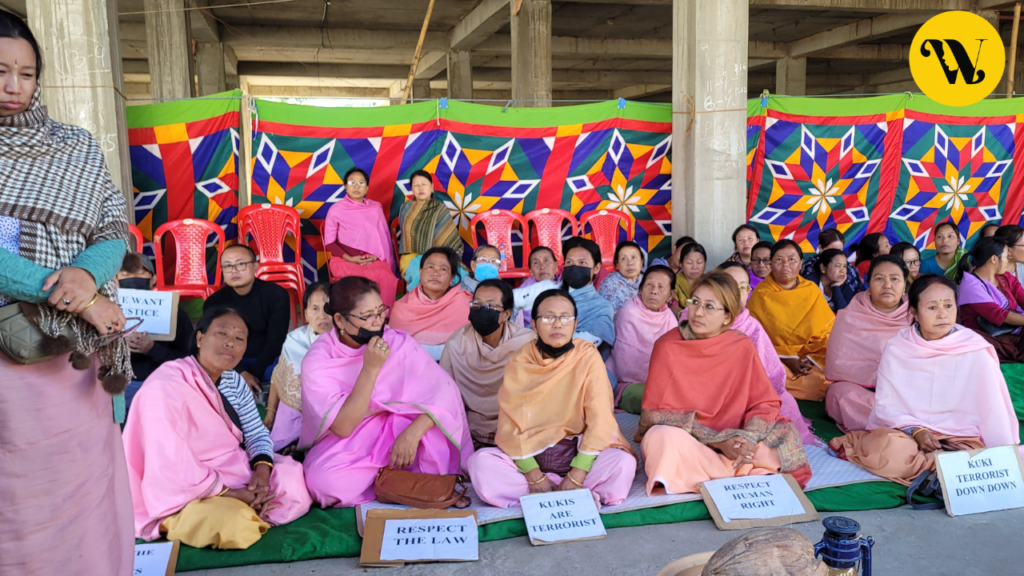
In the northeastern state of Manipur, unlike any other state, the majority of women were visible on the streets, running shops & engaging in business activities. There were marketplaces dedicated to all women sellers. It suggested that women in Manipur were empowered in some ways, but the reality showed otherwise. They are also the most targeted during these 18 months of ongoing violence.
It’s evident all over the world that women suffer the most from war. In the capital city of Manipur, a Meitei women’s group referred to as ‘Meira Paibi’ or ‘guardians of civil society’. These women torchbearers have been on an indefinite relay hunger strike since 16 November 2024. They first came into existence in 1977 and have led the protest against imposition of AFSPA (Armed Forces Special Powers Act, 1958) in Manipur.
They are protesting against the gruesome killing of 3 Meitei women & children in the Jiribam district. This happened in the fresh spate of violence in the state of Manipur. I spoke to these protesting women about their demands and how women were targeted on both sides.
One of the movement leaders Gurumayum Dayapati told me they needed justice for the 6 killings, they were demanding capital punishment. Speaking further she went on to voice a larger sentiment of the Meitei community saying, “All Kuki MLAs & Kuki Tribes organizations be declared as terrorists.”
In an interview given to The Womb, Dayapati said that they have lost all hope in the central and state governments seeing their behavior towards the ongoing violence.
I asked Gurumayum – “Since women are at the forefront of this war, they are the ones who are being targeted first and this was the case on both sides be it Kuki tribes or the Meitei community, so is Meira Paibi only protesting for the brutality against Meitei women or women in general?”. To this she responded, “All of us are living miserably, we are all innocent but they (Kukis) are killing our people.”
On speaking about the two Kuki women being paraded naked by the Meitei Mob she said, “They (Kukis) raped our women on the first day when the violence broke out, our boys got angry that’s why they went out to take revenge and the boys didn’t physically torture the girls, they were just paraded naked. We didn’t kill them.”
Gurumayum’s reply was chilling. I confirmed if she was justifying the shameful act of women being paraded naked, to which she said, yes, it was justified.
Ironically, a women’s group protesting for grisly crimes against women was justifying the same act done with the women of other communities by their community men.
This is the amount of venom and hatred spread between the two communities. It seemed to me that the ongoing violence and the horror stories of brutality that both sides have lived through in the last 18 months, has ushered in a certain myopia in people of both the communities, where they just cannot view the tensions from a third person perspective at all. To them, the other is the enemy. They are not willing to ask themselves – but how did we turn so against each other? Had we not lived peacefully all this while? Could people with vested interests be behind fuelling this and why? It is important to note that before the current spate of violence, both communities were living peacefully with each other – a sentiment repeated oft when asked about this in relief camps on both the sides.
National Media’s Gimmick in Imphal
Meanwhile, our mainstream media, critically known as ‘Godi Media’ is yet again busy with other ‘important’ issues, neglecting the crucial issue of a state burning, and hundreds of people dying.
National Media is simply paying lip service to the Manipur conflict and continuing with business as usual. I spotted several channels in Imphal, all these channels did was walk out of their lavish hotels, report from outside the hotel, and go back. They were least bothered to visit people in the relief camp, least bothered to go and meet the victims’ families and show the ground reality to the world.
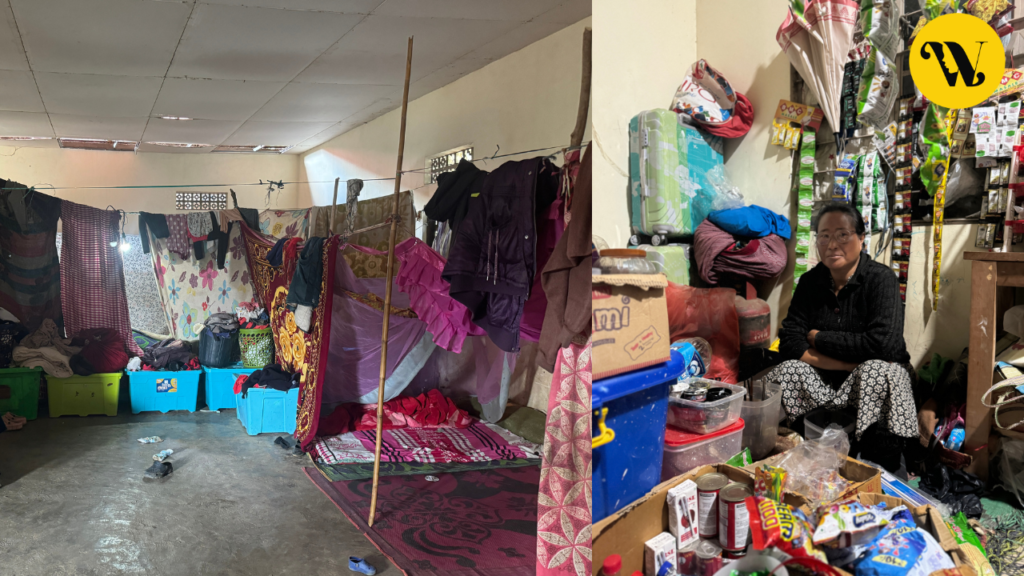
All they were doing was reporting on a whim and catering to the official narrative. Indian Media has fallen into an unofficial state of emergency. Once known as the ‘Fourth Pillar of Democracy’ is now a mere mouthpiece of the government. Manipur right now is in a sensitive spot where people all over the world need to know exactly what is happening in the state but there’s no factual information coming out in the media to inform citizens.
Core of the Dispute is Land Rights & Resources
The reality behind the ongoing violence in the state of Manipur can be understood in just one term- Political Cronyism. There’s a sinister angle to the 1.5-year-long violent conflict.
Manipur is rich in mineral resources, and all of these resources are concentrated in the hill areas of Manipur where the majority population is of Kuki-Zo-Chin tribals.
The government of India in 2015 & 2021 had already made amendments to the Mines & Minerals Development & Regulations Act, (MMDRA 1957) and with these amendments, they have taken away unqualified rights of the indigenous people over the surface lands that they have lived on for generations. This amendment has drawn various criticisms as it allows the government to overrule the Forest Rights Act 2006 and provide a shortcut for mining licenses. Now with the legal and policies front being clear, they only have to deal with one thing which is the tribes living on these lands.
We interviewed a Tribal leader & media spokesperson Ng Lun Kipgen in Manipur. He revealed some details of why the state of Manipur was burning and who was benefiting from this mayhem.
Lun Kipgen said, “It’s about the resources and land rights. In this conflict, I feel it’s about the land because that is the reason Meitei’s demanded to be given the ST status so that they can own land in the hills.”
“I feel Biren Singh along with the titular king have proposed this idea of granting ST Status to the Meitei community so that they have ownership of the lands and resources in the hills. Now to do that they had to stoop so low to demonize one community or maybe be involved in the ethnic cleansing of the Kuki-Zo tribes,” explained Ng Lun in an interview with The Womb.
Q. There are private companies that have been given mining contracts in Manipur so do you think they are in cahoots with both the Central and the State government?
A. When one talks about lands – some people reside there, so if the government takes up a major project, I think the local people should be included as stakeholders, that’s part of the system. I understand that when development needs to be done in your area, one has to be progressive but while doing so the government needs to give space to the tribal people. If it’s about their land they should be included, they should be part of the decision-making process, and that’s what happening throughout the world. So, it is safe to say that these private players who have been granted the mining license are in cahoots with the government. Otherwise, how can they skip the owner of the land?
Q. Since the government amended the MMDRA 1957 in 2021, so maybe now it’s just about removing people from these lands?
A. Very True, and this can only be achieved through this fascism upheld by the current Chief Minister otherwise the previous CM doesn’t have the guts to do that. The central Government needs someone like Biren Singh to do that otherwise the problem would have been solved on day 1 itself. The saddest part is people need to be educated on this aspect, that what is the sinister plan of the government behind this conflict, and what are they making out of planting the two communities against each other.
Human Rights Under Attack, Missing Leadership
There are two groups namely Arambai Tenggol and Meitei Leepun, these two are extremely active groups in the ongoing conflict in Manipur. Members of the Kuki-Zo group accused them of carrying out murderous attacks on them during the Manipur unrest. There are accusations that the state is supporting these groups as a private militia.
To no surprise, the Rajya Sabha MP and titular ling of Manipur, Leishemba Sanajaoba, was the one who formed the Meitei advocacy group Arambai Tenggol and continues to serve as its chairman. It has been said that Arambai Tenggol is an armed radical group. Additionally, it is a revivalist group that seeks to restore among the Meiteis the traditional, pre-Hindu Sanamahi faith.
The group showed its power in January 2024 when it called a conference of all the state’s elected Meitei lawmakers to discuss how to defend Meiteis in the ongoing struggle.
I reached out to 3 people from Arambai Tenggol for an interview. But was denied comment.
Arambai Tenggol has different unit offices set up all over Imphal. A source confirmed that they have taken over dislodged Kuki houses in Imphal to set up their units.
On the other hand, Meitei Leepun is led by Meitei Nationalist Pramot Singh. Meitei Leepun has also been held accountable for taking part in attacks against Kuki communities throughout the continuing wars. Pramot Singh was affiliated with ABVP during his college time in Gujarat. Manipur police have also filed a case against him for inciting hostility between groups. Singh has also been in the news last year for his vocal anti-Kuki stance.
Prima Facie, it seems that the Government of India does not want to intervene in these ethnic clashes. Because it is hard to believe that the Central Government isn’t able to curb the ongoing violence in 1.5 years. At this point, it might be safe to say that they lack the intention to restore peace in the state of Manipur.
Arms are being looted from the Police stations and still, they have not been recovered. What are the state police and army deployed doing? There’s AFSPA in place in hilly areas of the state but not in the valley except for the six police stations in Imphal closer to the hills. Doesn’t it all seem a bit planned and organized?
Numerous accounts exist of massacres, unrest, and long lines of shattered people, on both sides – Meitei and Kukis, heading in the direction of nowhere. But why is the country so quiet? Why does nobody care? Are people living in Manipur not the citizens of this country? Are they not our fellowmen? These are the questions that a sane society would ask but given we as a nation are doomed and far down the rabbit hole to question the wrongs we have been served, they remain unanswered, lost in the chaos of the clash and screams of the people drenched in blood.
Manipur is calling for our help. But are we there to answer? Or would we choose to remain silent just like those at whose behest this has been going on, in the first place?
The tears, sobs, silent cries, and stories with gory details from both Meiteis and Kukis did not leave me even after I returned to New Delhi. It seems to me that like always, and in any war – it is those who are at the lowest rung, who suffer the most. Common men and women from both Meitei and Kuki sides are suffering for no fault of their own – with their lives and their children’s lives staring in a limbo. All of them seem convinced that the Central government can end this war if it wants in a week’s time, but they seem increasingly convinced that it’s going to be a long-long time before they can go back to their villages and live a normal life.
What touched my heart the most was when we went to one relief camp from the other, and people asked – ‘How’s my village, how are people living on the other side?’ I could only smile and cry at the same time – a people uprooted from their homes, left to survive on the roads, staring into an unknown future and yet retaining their humanity in its full glory. It’s the sameness of emotions on both sides, that makes them not – the other side.
“Democracy is not merely a form of Government…It is essentially an attitude of respect and reverence towards fellowmen.”
― B.R. Ambedkar, Annihilation of Caste
Note: The views expressed here are of the author and the people interviewed. An honest attempt was made to reach out to as many people on both sides as possible.


